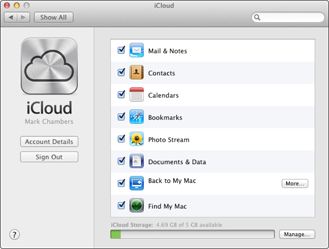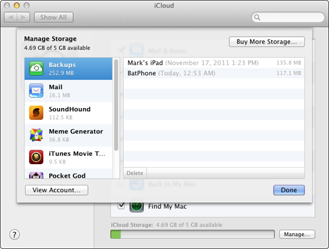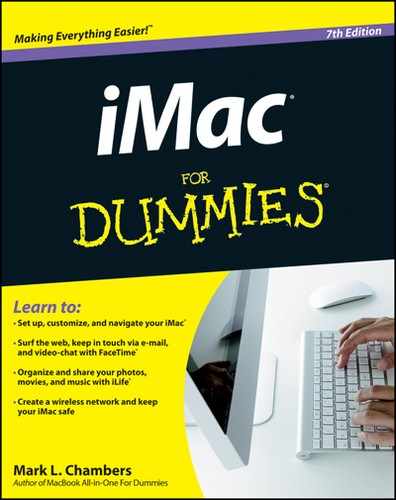Figure 9-1: iCloud works by pushing data between all your iOS devices.
Chapter 9
Expanding Your Horizons with iCloud
In This Chapter
![]() Introducing iCloud
Introducing iCloud
![]() Setting iCloud preferences
Setting iCloud preferences
![]() Managing iCloud storage
Managing iCloud storage
If you ask the average iMac owner about what’s available on the Internet, you likely hear benefits such as e-mail, Dropbox storage, Web surfing, RSS feeds, and Google searches. What you may not hear is “instant syncing among all my Apple iOS devices.”
If you have an iPhone, iPad, or iPod touch, you may have experienced what I like to call the Synchronizing Blues in the past: When you took a photo with your iPhone or created a new document with your iPad, your new additions just sat there (in their original location) until you had a chance to sync your device with your iMac. Ah, but with Apple’s new iCloud functionality, your stuff gets automatically synchronized across the Internet, and you can even keep your iTunes music library stored online!
In this chapter, I show you what’s really exciting about your iMac and that fancy Internet connection. With iCloud, you can automatically synchronize your stuff and manage online backups of all your contacts, calendars, mail, bookmarks, and documents!
So How Does iCloud Work, Anyway?
As I mentioned earlier, today’s Apple iOS devices can all display or play the same media: photos, music, books, and TV shows and such. Heck, some iOS devices can even share applications that you install, such as your iPhone and iPod touch. Therefore, it makes sense to effortlessly share all your digital media across these devices, and that’s what iCloud is all about. Apple calls this synchronization pushing.
Here’s a look at how the pushing process works. Imagine that you’ve just completed a Pages document on your iMac (an invitation for your son’s birthday party), but you’re at the office, and you need to get the document to your family so that they can edit and print it using your son’s iPad.
Before iCloud, you had to attach the document to an e-mail message, or upload it to some type of online storage like Dropbox, and then a family member had to download and save the document to the iPad before working with it. With iCloud, you simply save the document, and your iMac automatically pushes the document to the iPad! Your document appears on the iPad, ready to be opened, edited, and printed. (It appears on any other iOS 5 devices as well.) Figure 9-1 gives you an idea of what’s happening in the background when one of your devices pushes data using iCloud.

iCloud isn’t limited to just digital media, though. Your MacBook can also automatically synchronize your e-mail, iCal calendars, and Address Book contacts with other iOS 5 devices across the Internet, so staying in touch is much easier (no matter which device you happen to be using at the moment).
Apple also throws in 5GB of free online storage that you can use for all sorts of things: not only digital media files but also documents and anything else that you’d like to place online for safekeeping. In fact, items you buy through the iTunes Store — music, video, and applications — do not count against your 5GB limit. (More on how you can expand that 5GB limit later in the chapter.)
Configuring iCloud
You control all the settings for iCloud from Lion’s new iCloud pane in System Preferences (shown in Figure 9-2). Click the System Preferences icon in the Dock and click the iCloud icon. At the sign-in prompt, enter your Apple ID and your password. System Preferences will then guide you through basic iCloud configuration with a number of questions.
Figure 9-2: The iCloud pane appears within System Preferences.

Most of the check boxes on the iCloud Preferences pane control whether a particular type of data is pushed among all your iOS devices — data like Address Book contacts, Mail messages, and iCal calendars. However, you can enable three other unique features from this pane as well:
![]() Photo Stream: Turning on Photo Stream allows your iMac to automatically receive photos from your iOS devices. Take a photo with your iPhone, for example, and that image is immediately pushed to your iMac, iPad, and iPod touch. On the iMac, however, Photo Stream goes one step further: The photos appear automatically within iPhoto or Aperture within a special album titled Photo Stream.
Photo Stream: Turning on Photo Stream allows your iMac to automatically receive photos from your iOS devices. Take a photo with your iPhone, for example, and that image is immediately pushed to your iMac, iPad, and iPod touch. On the iMac, however, Photo Stream goes one step further: The photos appear automatically within iPhoto or Aperture within a special album titled Photo Stream.
 To turn Photo Stream on within iPhoto, click iPhoto⇒Preferences and click the Photo Stream button; then click all three check boxes to enable them. (Remember, Photo Stream must also be turned on within the iCloud Preferences pane.)
To turn Photo Stream on within iPhoto, click iPhoto⇒Preferences and click the Photo Stream button; then click all three check boxes to enable them. (Remember, Photo Stream must also be turned on within the iCloud Preferences pane.)
![]() Back to My Mac: If you enable Back to My Mac, you’ll be able to remotely control your iMac from another Mac computer (or vice versa) using Lion’s Screen Sharing feature. You can also transfer files between the two computers. Back to My Mac works over both a broadband Internet connection and a local network. Available Mac computers show up in the Shared section of the Finder window Sidebar. Note that you must manually turn on Screen Sharing within the System Preferences Sharing pane before you can remotely control another Mac.
Back to My Mac: If you enable Back to My Mac, you’ll be able to remotely control your iMac from another Mac computer (or vice versa) using Lion’s Screen Sharing feature. You can also transfer files between the two computers. Back to My Mac works over both a broadband Internet connection and a local network. Available Mac computers show up in the Shared section of the Finder window Sidebar. Note that you must manually turn on Screen Sharing within the System Preferences Sharing pane before you can remotely control another Mac.
![]() Find My Mac: Talk about Buck Rogers. . . Imagine locating a lost or stolen Mac from your iPhone or iPad. Now think about this: With Find My Mac, you can even lock or completely wipe your iMac’s hard drive remotely, preventing unauthorized use and erasing your private data! After you access your iMac from another iOS device, you can play a sound, send a message to be displayed onscreen, remotely lock the machine, or remotely wipe the drive. Note that after you have locked or wiped the drive, you can’t locate your iMac again.
Find My Mac: Talk about Buck Rogers. . . Imagine locating a lost or stolen Mac from your iPhone or iPad. Now think about this: With Find My Mac, you can even lock or completely wipe your iMac’s hard drive remotely, preventing unauthorized use and erasing your private data! After you access your iMac from another iOS device, you can play a sound, send a message to be displayed onscreen, remotely lock the machine, or remotely wipe the drive. Note that after you have locked or wiped the drive, you can’t locate your iMac again.
Managing Your iCloud Storage
Naturally, Apple knows that you’re curious about how much space you’ve taken up within your own personal iCloud. To monitor your iCloud storage, click the Manage button at the bottom-right corner of the iCloud Preferences pane. From the sheet that appears — as shown in Figure 9-3 — you can see how much space you’re using for document and data storage.
Click the data type in the left column, and iCloud displays the amount of storage space that’s being used for that data. For instance, in Figure 9-3, I’m checking the amount taken by my iPad and iPhone backups. (I’ve set both my iPad and iPhone to back up wirelessly to my iCloud storage.) Other items that might appear in this sheet include Mail and selected iPad and iPhone apps that support iCloud.
Figure 9-3: Checking on your iCloud storage.


